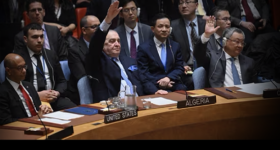
The Pentagon is working to encircle Eurasia and to surround the Eurasian Triple Entente composed of China, Russia, and Iran. For every reaction, however, there is a counter-reaction.
Neither one of these three Eurasian powers will sit ideally as passive US targets. Beijing, Moscow, and Tehran are all taking their own distinct counter-measures to oppose the Pentagon’s strategy of military encirclement.
In the Indian Ocean the Chinese are developing their military infrastructure under what the Pentagon calls the Chinese “string of pearls.” Iran is going through a process of naval expansion, which is seeing it deploy its maritime forces further and further from its home waters in the Persian Gulf and Gulf and Gulf of Oman.
All three Eurasian powers, along with several of their allies, also have naval vessels stationed off the shorelines of Yemen, Djibouti, and Somalia in the geo-strategically important maritime corridor of the Gulf of Aden:
The US global missile shield is a component of the Pentagon’s strategy to encircle Eurasia and these three powers. In the first instance, this military system is aimed at establishing the nuclear primacy of the US by neutralizing any Russian or Chinese nuclear response to a US or NATO attack. The global missile shield is aimed at preventing any reaction or nuclear “second strike” by the Russians and Chinese to a nuclear “first strike” by the Pentagon.
US Global Missile Shield versus Russian Naval Expansion
All the new reports about branches of the US missile shield being established in other parts of the world are sensationalized in terms of the how they are portraying its geographic expansion as a new development. These reports ignore the fact that the missile shield was designed to be a global system with components strategically positioned across the world from the onset. The Pentagon had planned this in the 1990s and maybe much earlier. Japan and the Pentagon’s NATO allies have more or less been partners in the military project from the start.
Years ago both the Chinese and Russians were aware of the Pentagon’s global ambitions for the missile shield and made joint statements condemning it as a destabilizing project that would disturb the global strategic balance of power. China and Russia even jointly issued multilateral statements in July 2000 with Kazakhstan, Kyrgyzstan, and Tajikistan warning that the creation of the Pentagon’s global missile shield would work again international peace contravened the Anti-Ballistic Missile (ABM) Treaty. The US government was repeatedly warned that the steps it was taking would polarize the globe with hostilities that would be reminiscent of the Cold War. The warning fell on deaf and arrogant ears.
The Russians are now rebutting the Pentagon’s global missile shield through very practical steps of their own. These steps involve an expansion of their country’s presence in the high seas and an upgrade of their naval capabilities. Moscow plans on opening new naval bases outside of its home waters and outside of both the shorelines of the Black Sea and Mediterranean Sea.
The Russian Federation already has two naval bases outside of Russian territory; one is in the Ukrainian port of Sevastopol in the Black Sea and the other is in the Syrian port of Tartus in the Mediterranean Sea. The Kremlin is now looking at the Caribbean Sea, South China Sea, and eastern coast of Africa (in close proximity to the Gulf of Aden) as suitable locations for new Russian bases. Cuba, Vietnam, and the Seychelles are the prime candidates to host new Russian naval bases in these waters.
The Russians already had a presence in Vietnam’s Cam Ranh Bay until 2002. The Vietnamese port was home to the Soviets since 1979 and then hosted Russian forces after the breakup of the Soviet Union in 1991. Russia also continued to have a post-Soviet military presence in Cuba until 2001 through the Lourdes intelligence signal base that monitored the US.
The Kremlin is additionally developing its military infrastructure on its Arctic coast. New Arctic naval bases in the north are going to be opened. This is part of an overlap with the careful Russian strategy that includes the Arctic Circle. It is drawn with two dual functions in mind. One function is to protect Russian territorial and energy interests against NATO states in the Lomonosov Ridge. The other purpose is to serve the Russian global maritime strategy.
Moscow realizes that the US and NATO want to restrictively hem in its maritime forces in the Black Sea and Mediterranean Sea. US and EU moves to control and restrict Russian maritime access to Syria is an indicator of this strategic inclination and objective. The moves to strategically hem in Russian marine forces are one of the reasons that the Kremlin wants naval bases in the Caribbean, South China Sea, and eastern coast of Africa.
The development of Russia’s Arctic naval infrastructure and the opening of Russian naval bases in places like Cuba, Vietnam, and the Seychelles would virtually guarantee the global presence of Russian naval forces. Russian vessels would have multiple points of entry into international waters and secure docking bases abroad. These bases will give the Russians permanent docking facilities in both the Atlantic Ocean and Indian Ocean too.
The future overseas naval bases, like the one is Syria, are not being referred to as “naval bases” by Russian officials, but by other terms. Moscow is calling them “supply points” or bases for naval logistics to make them sound far less threatening. The nomenclature does not really matter. The functions of these naval facilities, however, are for the strategic military purposes that are being outlined.
The Russians at present only have permanent docking bases on their own national coastlines in the Arctic Ocean and Pacific Ocean. Moreover, Russia’s naval infrastructure in the Russian Far East, on the shores of the Pacific Ocean, has the greatest access to open international waters. Moscow’s naval infrastructure in the Baltic is geographically in a constrained environment and could be immobilized, like Russia’s naval infrastructure in the Black Sea, in the event of a confrontation with the US and NATO. The addition of the naval infrastructure in places like Cuba would effectively guarantee that Russia’s naval forces will have a free hand and not be hemmed in by the US and its allies.
Russia’s New Nuclear Posture at Sea
Historically, the mandate of the naval forces of the Russian Armed Forces has been to protect the Russian coast. Both Russia and the Soviet Union based their defensive strategies on countering a major land invasion. For this reason both the characteristics of the Russian and Soviet naval forces were always based on functions aimed at helping fight a land-based invasion. Thus, the Russian naval fleet has not been structured as an offensive attack force. This, however, is changing as part of Moscow’s reaction to the Pentagon’s strategy of encirclement.
Russia, like both China and Iran, is now focusing on sea power.
Russia is upgrading and expanding its nuclear naval fleet. The Russian media has referred to this as a new bid for their country’s “naval dominance.” Moscow’s aims are to establish the nuclear superiority of its naval fleet with sea-based nuclear attack capabilities. This is a direct reaction to the Pentagon’s global missile shield and the encirclement of Russia and its allies.
Over fifty new warships and more than twenty new submarines will be added to the Russian fleet by 2020. About 40% of the new Russian submarines will have lethal nuclear strike capabilities. This process started after the Bush Jr. White House began taking steps to establish the US missile shield in Europe.
In the last few years, Russia’s counter-measures to the US missile shield have begun to manifest themselves. Trials of Russia’s Borey class submarine in the White Sea, where the port of Archangel (Arkhangelsk) is situated, began in 2011. In the same year the development of the submarine-launched Liner ballistic nuclear missile was announced, which was said to be able to pierce through the US missile shield. A Russian submarine would secretly test the Liner from the Barents Sea in 2011.
Future Cuba Missile Crisis in the Making?
If an agreement is reached with Havana, there is always the possibility that Russia may deploy missiles to Cuba like the Soviets did. Speaking in the realm of the hypothetical, these Russian missiles would most probably have nuclear warheads. Simplistically, this can be portrayed as a replay of the scenario that led to the Cuban Missile Crisis between the US, Soviet Union, and Cuba in 1962. There is much more, however, to the background of this Cold War story and its causes and effects.
The chief perpetrator of the Cuban Missile Crisis was the US government. The deployment of Soviet nuclear missiles to Cuba was a strategically asymmetric move to counter-balance the secret deployment of US nuclear missiles to Turkey, which targeted Soviet cities and citizens. The US government did not let its citizens know about its own nuclear missiles in Turkey that were targeting the Soviet population, because it would have led to many questions by the US public about whom the real aggressors were and what side was really at fault for the sparking of the crisis in 1962. The future deployment of Russian nukes to Cuba would likewise be a reaction to the nuclear weapons that the Pentagon is surrounding Russia and her allies with. Like in 1962, the US government would be at fault once again if nuclear missiles are deployed to Cuba and a crisis emerges.
Hereto, there are only talks underway about a renewed Russian presence in Cuba. Nothing has been agreed upon in concrete terms between the governments in Havana and Moscow, and there has been no mention of deploying Russian missiles to Cuba. Any comments about Russian moves in Cuba are speculation.
The nuclear upgrades that Russia is making to its navy are much more significant than any future Russian base in Cuba or elsewhere. Russia’s new nuclear naval posture actually allows it to cleverly station multiple mobile nukes around the US. In other words, Russia has “multiple Cubas” in the form of its floating mobile nuclear naval vessels that can deploy anywhere in the world. This is also why Russia is developing is naval infrastructure abroad. Russia will have the option of surrounding or flanking the United States with its own sea-based nuclear strike forces.
Russia’s naval strategy cleverly is meant to counter the Pentagon’s global missile shield. Included in this process is the adoption of a pre-emptive nuclear strike policy by the Kremlin as a reaction to the aggressive pre-emptive post-Cold War nuclear strike doctrine of the Pentagon and NATO. In the same year as the test of the Liner by the Russians, the commander of the Strategic Rocket Forces of the Russian Federation, Colonel-General Karakayev, said that Russia’s inter-continental ballistic missiles would become “invisible” in the near future.
The world is increasingly becoming militarized. US moves and actions are now forcing other international actors to redefine and reassess their military doctrines and strategies. Russia is merely just one of them.
Source: Press Tv
READ MORE EURASIAN NEWS AT: 21st Century Wire Eurasia Files















